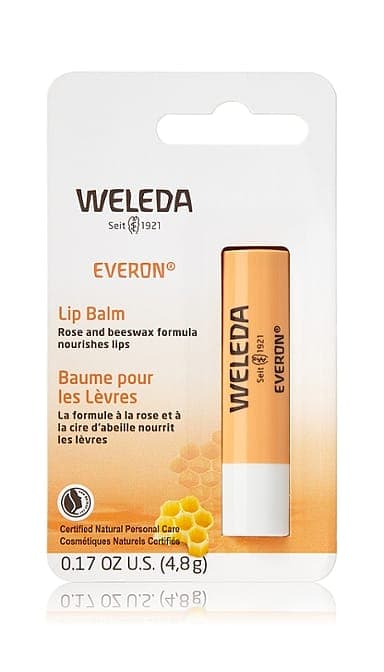
Everon Lip Balm
Weleda
7.2/10 (38 reviews)
lip balmdry, delicate skin0.17 fl oz
Key Benefits
- Jojoba oil for lightweight, long-lasting moisture
- Shea butter for deep nourishment and barrier repair
- Beeswax for occlusive protection and moisture retention
Overall Score: 7.2/10
Good natural lip balm for most users seeking moisture and protection, but those with fragrance allergies or seeking vegan products should avoid.
✨
Protect Your Skin Against Hidden Toxins & Chemicals Forever
Check ingredients of any lipstick, deodorant, moisturizer and other cosmetics to check for hormone disruptors, skin damaging chemicals & allergens while you're shopping with SkinCosmo.
Detailed Product Scores
Overall
7.2/10
Weighted average of all factors
Safety
7/10
Allergen and irritation risk assessment
Efficacy
8.2/10
Expected performance and results
Formulation
7.8/10
Ingredient synergy and stability
Sustainability
6.5/10
Environmental and ethical impact
Benefits & Concerns
Key Benefits (3)
- Jojoba oil for lightweight, long-lasting moisture
- Shea butter for deep nourishment and barrier repair
- Beeswax for occlusive protection and moisture retention
Concerns & Limitations (2)
- Fragrance and EU-listed allergens (Limonene, Linalool, Citronellol, Geraniol, Citral, Eugenol, Farnesol) may cause irritation or allergic reactions in sensitive individuals
- Not vegan due to beeswax
Complete Ingredient Analysis
14
Total Ingredients
5
Emollients
9
Fragrances
0
Unsafe
Complete Ingredient Breakdown
Listed in order of concentration with detailed analysis
#1
Simmondsia Chinensis (Jojoba) Seed Oil
Simmondsia Chinensis (Jojoba) Seed Oil
unknownemollient
#2
Beeswax (Cera Alba)
Beeswax (Cera Alba)
unknownemollient
#3
Euphorbia Cerifera (Candelilla) Wax
Euphorbia Cerifera (Candelilla) Wax
unknownemollient
#4
Butyrospermum Parkii (Shea) Butter
Butyrospermum Parkii (Shea) Butter
unknownemollient
#5
Copernicia Cerifera (Carnauba) Wax
Copernicia Cerifera (Carnauba) Wax
unknownemollient
#6
Fragrance (Parfum)
Fragrance (Parfum)
unknownfragrance
#7
Limonene
Limonene
unknownfragrance
#8
Linalool
Linalool
unknownfragrance
#9
Citronellol
Citronellol
unknownfragrance
#10
Benzyl Alcohol
Benzyl Alcohol
unknownfragrance
#11
Geraniol
Geraniol
unknownfragrance
#12
Citral
Citral
unknownfragrance
#13
Eugenol
Eugenol
unknownfragrance
#14
Farnesol
Farnesol
unknownfragrance
Product Attributes
Vegan
Cruelty-Free
Reef Safe
Alcohol-Free
Paraben-Free
Silicon-Free
Sulfate-Free
Fragrance-Free
EU Allergen-Free
Oil-Free
Fungal Acne Safe
Usage Instructions & Guidelines
Official Usage Instructions
Manufacturer's recommended application
Ideal For:
- •Dry, chapped, or cracked lips
- •Daily lip maintenance routine
- •Cold weather protection
- •Sensitive skin types
- •Natural skincare enthusiasts
Avoid If You Have:
- •Known allergies to listed ingredients
- •Very sensitive or reactive skin
- •Strict vegan lifestyle requirements
- •Preference for fragrance-free products
Product Alternatives
Vegan lip balm Alternatives
SQUALANE + AMINO ACIDS LIP BALM - Lippenbalsem
The Ordinary
8.6/10
Vegan
Fragrance-Free
Honest Lip Balm
Benton
8.3/10
Vegan
Fragrance-Free
Lip Glowy Balm
LANEIGE
7.2/10
Vegan
Drs Leenarts Lipcare+ Lippenbalsem
Drs Leenarts
7.2/10
Vegan
Fragrance-Free
🧴
Vaseline Lip Therapy Mini Lip Balm
Vaseline
6.5/10
Vegan
Fragrance-Free lip balm Alternatives
SQUALANE + AMINO ACIDS LIP BALM - Lippenbalsem
The Ordinary
8.6/10
Vegan
Fragrance-Free
Honest Lip Balm
Benton
8.3/10
Vegan
Fragrance-Free
MOISTURE SURGE LIP HYDRO PLUMP TREATMENT - Lippenbalsem
Clinique
7.2/10
Fragrance-Free
Drs Leenarts Lipcare+ Lippenbalsem
Drs Leenarts
7.2/10
Vegan
Fragrance-Free
Popular lip balm Alternatives
SQUALANE + AMINO ACIDS LIP BALM - Lippenbalsem
The Ordinary
8.6/10
Vegan
Fragrance-Free
Honest Lip Balm
Benton
8.3/10
Vegan
Fragrance-Free
Weleda Everon Lip Balm, Soin Des Levres - 0.17 Oz, White
Weleda
7.2/10
🧴
Weleda Everon Lippenbalsem
Weleda
7.2/10
Weleda Everon Lip Balm 4.8G
Weleda
7.2/10
Enhanced content is being generated for this product. Check back soon for additional insights.